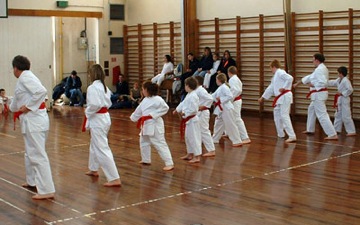KIHON
Kihon is the basic training drills of karate, often referred to as "line work".

Karate is a martial art, and the Kihon reflects typical martial/military training methods for a large group of people to practice their skills. Traditionally Kihon is performed in lines with all students performing the same techniques, similar to soldiers marching on a parade ground. The instructor stands at the front and issues commands to the rank and file, who then perform the appropriate techniques. In the ranks the higher grades are at the front and the beginners at the back, with the highest grade at the front right hand side and the lowest grade at the back left hand side.
Kihon is a very general term and can also apply to pair work and even to solo exercises which are not Kata. There comes a time when marching up and down in lines practicing a particular block is not enough and you need to test your skill in the execution of that block against an attack without going as far as "real" fighting. This is where two person Kihon is useful - your partner attacks you with a set kick/punch and you perform your block to deflect it. Repeated over and over faults and inefficiencies in your technique can be eradicated with relative safety. The obvious next step is to progress to Ippon Kumite (one step fighting) where there is a defined Attack, Block and Counter-attack.
The concept of Kihon is based on sound sporting and psychological concepts. Each person has a set of "instinctive" responses to a particular situation. For example ...
If you knock a coffee cup off a table do you ...
- let it fall.
- try to catch it with your hands.
- try to slow its descent with your foot.
- run away.
- some other action.
If you once tried to catch a full cup of boiling hot coffee and scalded yourself you will tend to stand back and let it fall. If you value your china over your own safety you may try to catch it using your hands, or a compromise by trying to break it's fall with your foot (if you have been scalded in the past). You may have had another learning experience which could have installed another automatic response such as running away if you have a "coffee cup phobia"!
Or you may do something completely different ...
A natural dominant response to an incoming blow to the head would be to turn your head away and protect it by placing your arms in the way. Kihon tries to modify a natural set of dominant responses into a set of selected "defensive" dominant responses. The karate induced dominant response to an incoming blow to the head would be to lower your body into a balanced stable stance, shift off the line of attack, execute a block to deflect the blow and protect yourself then instigate an action of your own to prevent the attacker from continuing to attack you.
The Kihon training drills are a simple, basic foundation for converting and/or installing dominant responses so in an aggressive situation you don't think, you do. Kihon may be repetitious and occasionally tedious, but at the end of the day Kihon can be the difference between someone who thinks they can defend themselves and someone who defends themselves without having to think. It is not uncommon for a Karateka to be attacked and to react "instinctively" to the extent that the aggressor is lying on the floor and the karateka has no idea which block/counter they used to defend themselves!
The day that happens is the day that you realise that your karate is really working for you!

